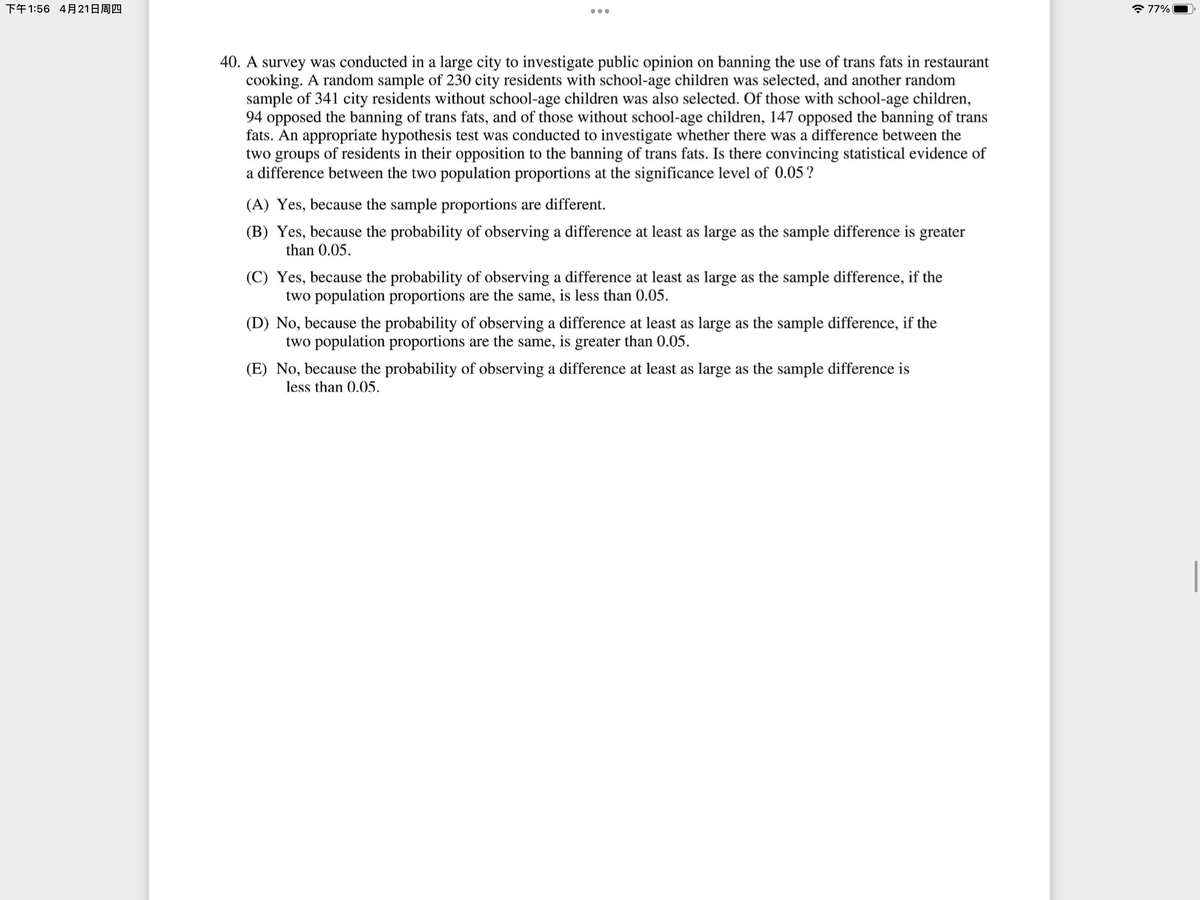40. A survey was conducted in a large city to investigate public opinion on banning the use of trans fats in restaurant cooking. A random sample of 230 city residents with school-age children was selected, and another random sample of 341 city residents without school-age children was also selected. Of those with school-age children, 94 opposed the banning of trans fats, and of those without school-age children, 147 opposed the banning of trans fats. An appropriate hypothesis test was conducted to investigate whether there was a difference between the two groups of residents in their opposition to the banning of trans fats. Is there convincing statistical evidence of a difference between the two population proportions at the significance level of 0.05? (A) Yes, because the sample proportions are different. (B) Yes, because the probability of observing a difference at least as large as the sample difference is greater than 0.05. (C) Yes, because the probability of observing a difference at least as large as the sample difference, if the two population proportions are the same, is less than 0.05. (D) No, because the probability of observing a difference at least as large as the sample difference, if the two population proportions are the same, is greater than 0.05. (E) No, because the probability of observing a difference at least as large as the sample difference is less than 0.05.
40. A survey was conducted in a large city to investigate public opinion on banning the use of trans fats in restaurant cooking. A random sample of 230 city residents with school-age children was selected, and another random sample of 341 city residents without school-age children was also selected. Of those with school-age children, 94 opposed the banning of trans fats, and of those without school-age children, 147 opposed the banning of trans fats. An appropriate hypothesis test was conducted to investigate whether there was a difference between the two groups of residents in their opposition to the banning of trans fats. Is there convincing statistical evidence of a difference between the two population proportions at the significance level of 0.05? (A) Yes, because the sample proportions are different. (B) Yes, because the probability of observing a difference at least as large as the sample difference is greater than 0.05. (C) Yes, because the probability of observing a difference at least as large as the sample difference, if the two population proportions are the same, is less than 0.05. (D) No, because the probability of observing a difference at least as large as the sample difference, if the two population proportions are the same, is greater than 0.05. (E) No, because the probability of observing a difference at least as large as the sample difference is less than 0.05.
Holt Mcdougal Larson Pre-algebra: Student Edition 2012
1st Edition
ISBN:9780547587776
Author:HOLT MCDOUGAL
Publisher:HOLT MCDOUGAL
Chapter11: Data Analysis And Probability
Section: Chapter Questions
Problem 8CR
Related questions
Question

Transcribed Image Text:下午1:56 4月21日周四
* 77%
•..
40. A survey was conducted in a large city to investigate public opinion on banning the use of trans fats in restaurant
cooking. A random sample of 230 city residents with school-age children was selected, and another random
sample of 341 city residents without school-age children was also selected. Of those with school-age children,
94 opposed the banning of trans fats, and of those without school-age children, 147 opposed the banning of trans
fats. An appropriate hypothesis test was conducted to investigate whether there was a difference between the
two groups of residents in their opposition to the banning of trans fats. Is there convincing statistical evidence of
a difference between the two population proportions at the significance level of 0.05?
(A) Yes, because the sample proportions are different.
(B) Yes, because the probability of observing a difference at least as large as the sample difference is greater
than 0.05.
(C) Yes, because the probability of observing a difference at least as large as the sample difference, if the
two population proportions are the same, is less than 0.05.
(D) No, because the probability of observing a difference at least as large as the sample difference, if the
two population proportions are the same, is greater than 0.05.
(E) No, because the probability of observing a difference at least as large as the sample difference is
less than 0.05.
Expert Solution
This question has been solved!
Explore an expertly crafted, step-by-step solution for a thorough understanding of key concepts.
This is a popular solution!
Trending now
This is a popular solution!
Step by step
Solved in 4 steps with 3 images

Recommended textbooks for you

Holt Mcdougal Larson Pre-algebra: Student Edition…
Algebra
ISBN:
9780547587776
Author:
HOLT MCDOUGAL
Publisher:
HOLT MCDOUGAL

Glencoe Algebra 1, Student Edition, 9780079039897…
Algebra
ISBN:
9780079039897
Author:
Carter
Publisher:
McGraw Hill

Holt Mcdougal Larson Pre-algebra: Student Edition…
Algebra
ISBN:
9780547587776
Author:
HOLT MCDOUGAL
Publisher:
HOLT MCDOUGAL

Glencoe Algebra 1, Student Edition, 9780079039897…
Algebra
ISBN:
9780079039897
Author:
Carter
Publisher:
McGraw Hill